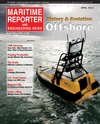
Page 27: of Maritime Reporter Magazine (April 2014)
Offshore Edition
Read this page in Pdf, Flash or Html5 edition of April 2014 Maritime Reporter Magazine
www.marinelink.com 27Defendant denies it breached the con-tract, and it contends that even if it did, the direct damages are only half of what plaintiff claims. It further contends that plaintiff is not entitled to consequential damages. If the matter goes to litigation, each side is likely to incur $20,000 in at-torneys? fees and costs, and the contract states that neither party can recover fees and costs from the other side.How does one begin to analyze the settlement value of a claim like this? The answer is to break it down into all of the possible outcomes and then to as-cribe a probability of occurrence to each possible outcome. Here, one possible outcome is that the defendant wins a judgment that it did not breach the con-tract. Let?s say the plaintiff has analyzed the claim and concludes there is a 30% chance that may happen. That means plaintiff considers there is a 70% prob- ability that it will win. But, even if it wins, let?s say plaintiff estimates that it has only a 60% chance of recovering its full claimed direct damages (as opposed to half) and only a 50% probability of re-covering consequential damage.We can analyze the expected value of the claim in a chart which shows each possible outcome, the likelihood each outcome will occur, and thus each pos- sible scenario?s contribution to the over- all expected value of the case:(See chart to the left on page 26) You can see from the chart that there are four potential outcomes: one in which the defendant wins, and three in which the plaintiff recovers different sums depending on how the damages is-sues turn out. The chart allows one to calculate ?compound probabilities,? that is, the likelihood of a chain of events taking place, and then Þ t each alternative outcome into the overall picture.Of course, most litigations will be more complex than this, but the same technique can be expanded as neces-sary to account for any number of vari-able outcomes, such as counterclaims, dispositive motions, variable damages awards (i.e. where the potential damages are not Þ xed at a known dollar amount) and so forth. The analysis may be more challenging, but as the case gets more complicated the analysis becomes all the more useful.Attorneys? Fees, Costs & Other Factors There is one critical factor that the Ex-pected Value Analysis does not account for, and that is costs. Anyone analyzing the settlement value of a case obviously has to be cognizant of what it will cost to accomplish the forecasted result. In the above example, we know that plain-tiff and defendant are each estimated to spend $20,000 to get to a verdict. So, if each party is analyzing this issue at the beginning of the case (i.e. before it has spent those fees), then an economist would say that the plaintiff should be willing to settle the case for any value greater than $60,500 (i.e. $80,500 ex-pected value less $20,000 costs), and the defendant should be willing to settle the case for any value below $100,500 (i.e. MR #4 (26-33).indd 27MR #4 (26-33).indd 274/4/2014 10:49:20 AM4/4/2014 10:49:20 AM

 26
26

 28
28
